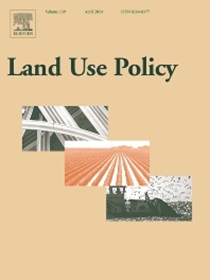Mitigating conflicts in the implementation of intensive land use policies: Insights from a tripartite evolutionary game model
IF 6
1区 社会学
Q1 ENVIRONMENTAL STUDIES
引用次数: 0
Abstract
Various levels of Chinese governments have implemented several intensive land use policies (ILUP) to manage the unending extensive urbanization. However, the aspect of conflicting interests and goals at the national level (NL), local levels (LL) and land users (LU) creates resistance to the implementation of ILUP. Recognizing and studying the conflicting nature of the three parties is beneficial to mitigate the challenges of policy implementation. This paper aims to clarify the conflict mechanisms among actors in intensive land use and provide insights into mitigating conflicts in the ILUP transmission process. A combination of qualitative and quantitative approaches based on tripartite evolutionary game model were used to address the antagonism in policy implementation. The findings suggest that: (1) Policy transmission mainly led by the NL, while collaboration between the LL and LU can facilitate such transmission. (2) The interaction between LL and LU exhibits an asymmetric impact. Notably, increasing the participation intention of LU alone (20 %-40 %) has a greater effect compared to LL (40 %-60 %). (3) Enforcement of punitive measures (40 %-60 %) proves to be more efficient than rewarding measures (over 60 %) with regards to policy transmission. Moreover, direct role of NL to LL facilitates cooperation. (4) The priority of the mechanism of costs-benefits variables is as follows: reducing policy implementation costs of LL (around 15 %) > decreasing costs for LU = increasing benefits for LU (10 %-20 %) > increasing policy implementation benefits of LL (40 %-60 %) > lowering supervision costs of NL (around 100 %) > increasing external benefits of NL. This paper takes game theory to recognize and mitigate the contradictory relationship between the three parties, and provides insightful suggestions for a more effective future policy evolution.
求助全文
约1分钟内获得全文
求助全文
来源期刊

Land Use Policy
ENVIRONMENTAL STUDIES-
CiteScore
13.70
自引率
8.50%
发文量
553
期刊介绍:
Land Use Policy is an international and interdisciplinary journal concerned with the social, economic, political, legal, physical and planning aspects of urban and rural land use.
Land Use Policy examines issues in geography, agriculture, forestry, irrigation, environmental conservation, housing, urban development and transport in both developed and developing countries through major refereed articles and shorter viewpoint pieces.
 求助内容:
求助内容: 应助结果提醒方式:
应助结果提醒方式:


